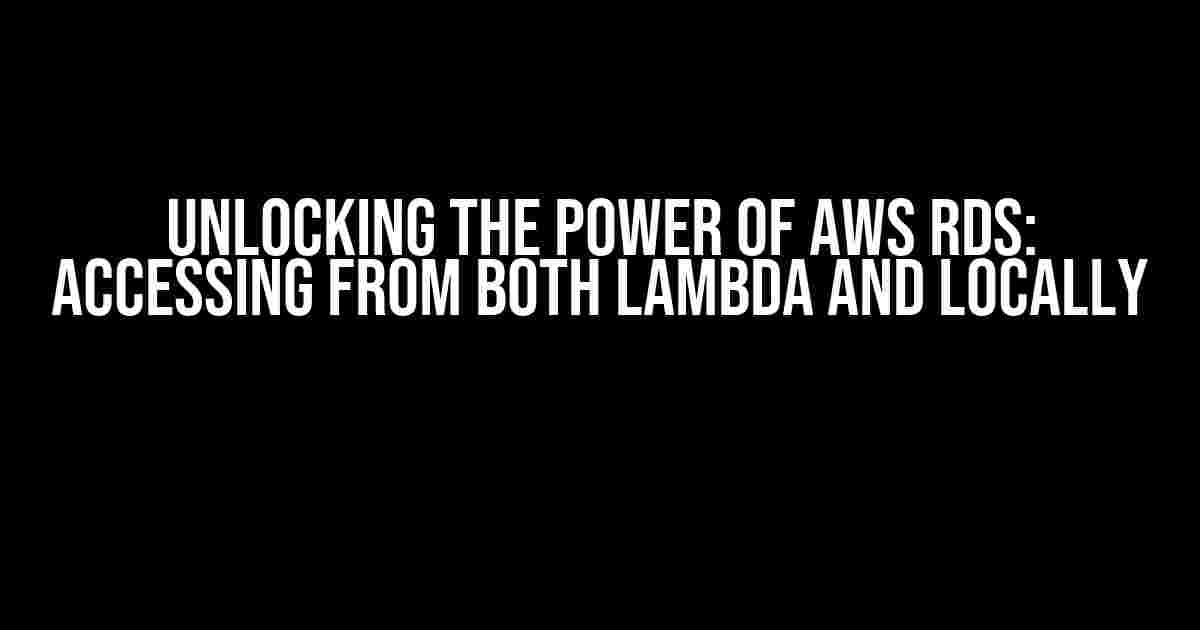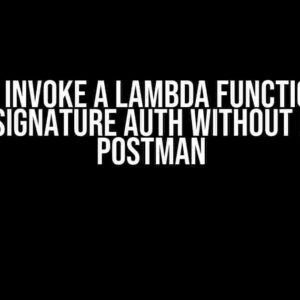Are you tired of navigating the complexities of accessing your AWS RDS instance from both Lambda functions and local environments? Worry no more! In this comprehensive guide, we’ll take you by the hand and walk you through the process of setting up seamless connections to your RDS instance, regardless of where you’re accessing it from.
- Why Access AWS RDS from Both Lambda and Locally?
- Prerequisites
- Step 1: Configure RDS Instance Security
- Step 2: Update RDS Instance Settings
- Step 3: Set up Lambda Function Environment Variables
- Step 4: Access RDS Instance from Lambda Function
- Step 5: Access RDS Instance Locally
- Step 6: Configure Local Environment Variables
- Step 7: Access RDS Instance Locally
- Conclusion
Why Access AWS RDS from Both Lambda and Locally?
Before we dive into the nitty-gritty, let’s talk about why accessing your RDS instance from both Lambda and local environments is crucial:
- Serverless Architecture**: By integrating your RDS instance with Lambda functions, you can build scalable, serverless applications that automatically adjust to changing workloads.
- Local Development**: Accessing your RDS instance locally enables you to develop, test, and debug your applications more efficiently, reducing the need for costly deployments and downtime.
- Faster Development Cycles**: With access to your RDS instance from both environments, you can iterate faster, experiment with new ideas, and ship features more quickly.
Prerequisites
Before we begin, make sure you have the following:
- An AWS account with an RDS instance set up
- A Lambda function created in the same AWS region as your RDS instance
- A local machine with a compatible operating system (Windows, macOS, or Linux)
- A valid AWS access key pair (optional, but recommended for local access)
Step 1: Configure RDS Instance Security
To allow incoming connections from both Lambda and local environments, you need to configure the security settings for your RDS instance:
- Log in to the AWS Management Console and navigate to the RDS dashboard.
- Select your RDS instance and click on “Instance settings” in the top-right corner.
- Scroll down to the “Security” section and click on “Edit” next to “VPC security groups”.
- In the “VPC security groups” page, click on “Add security group” and create a new security group.
- Name the security group (e.g., “rds-access”) and add the following inbound rules:
| Protocol | Port range | Source |
|---|---|---|
| TCP | 3306 (or your RDS instance port) | Anywhere (0.0.0.0/0, ::/0) |
NB:** Make sure to replace the port number with the one used by your RDS instance.
Step 2: Update RDS Instance Settings
Now, let’s update the RDS instance settings to allow connections from both environments:
- Go back to the RDS instance settings page and scroll down to the “DB instance” section.
- Click on “Edit” next to “DB instance settings”.
- In the “DB instance settings” page, make sure the “Publicly accessible” option is set to “Yes”.
- Set the “Security group” option to the one you created in Step 1 (e.g., “rds-access”).
- Click “Apply immediately” to save the changes.
Step 3: Set up Lambda Function Environment Variables
To access your RDS instance from a Lambda function, you need to configure environment variables:
- Navigate to the Lambda function page and click on “Configuration” in the top-right corner.
- Scroll down to the “Environment variables” section and click on “Edit”.
- Add the following environment variables:
| Variable name | Value |
|---|---|
| RDS_HOSTNAME | Your RDS instance hostname (e.g., “my-rds-instance.abcdefg.us-east-1.rds.amazonaws.com”) |
| RDS_DB_NAME | Your RDS instance database name (e.g., “mydb”) |
| RDS_USERNAME | Your RDS instance username (e.g., “myuser”) |
| RDS_PASSWORD | Your RDS instance password (e.g., “mypassword”) |
Step 4: Access RDS Instance from Lambda Function
Now that you’ve set up the environment variables, you can access your RDS instance from your Lambda function:
import boto3
import MySQLdb
# Initialize RDS connection
rds_host = os.environ['RDS_HOSTNAME']
rds_db = os.environ['RDS_DB_NAME']
rds_user = os.environ['RDS_USERNAME']
rds_password = os.environ['RDS_PASSWORD']
conn = MySQLdb.connect(
host=rds_host,
user=rds_user,
passwd=rds_password,
db=rds_db
)
# Perform database operations
cursor = conn.cursor()
cursor.execute("SELECT * FROM mytable")
results = cursor.fetchall()
# Close the connection
conn.close()
Step 5: Access RDS Instance Locally
To access your RDS instance from your local machine, you’ll need to create a new user with the necessary permissions:
- Log in to your RDS instance using a tool like HeidiSQL or SQL Workbench/J.
- Create a new user with the following command:
CREATE USER 'local_user'@'%' IDENTIFIED BY 'local_password';
NB:** Replace ‘local_user’ and ‘local_password’ with your desired username and password.
- Grant the new user the necessary permissions:
GRANT ALL PRIVILEGES ON *.* TO 'local_user'@'%';
NB:** Be cautious when granting privileges, as this can pose a security risk if not done correctly.
Step 6: Configure Local Environment Variables
To access your RDS instance from your local machine, you need to set environment variables:
- On Windows, use the following command:
set RDS_HOSTNAME=my-rds-instance.abcdefg.us-east-1.rds.amazonaws.com set RDS_DB_NAME=mydb set RDS_USERNAME=local_user set RDS_PASSWORD=local_password
- On macOS or Linux, use the following command:
export RDS_HOSTNAME=my-rds-instance.abcdefg.us-east-1.rds.amazonaws.com export RDS_DB_NAME=mydb export RDS_USERNAME=local_user export RDS_PASSWORD=local_password
Step 7: Access RDS Instance Locally
Now that you’ve set up the environment variables, you can access your RDS instance from your local machine:
import mysql.connector
# Initialize RDS connection
rds_host = os.environ['RDS_HOSTNAME']
rds_db = os.environ['RDS_DB_NAME']
rds_user = os.environ['RDS_USERNAME']
rds_password = os.environ['RDS_PASSWORD']
conn = mysql.connector.connect(
host=rds_host,
user=rds_user,
password=rds_password,
database=rds_db
)
# Perform database operations
cursor = conn.cursor()
cursor.execute("SELECT * FROM mytable")
results = cursor.fetchall()
# Close the connection
conn.close()
Conclusion
Voilà! You’ve successfully set up access to your AWS RDS instance from both Lambda functions and local environments. With this comprehensive guide, you should now be able to seamlessly connect to your RDS instance from anywhere, whenever you need to.
Remember to stay secure, keep your access keys and passwords safe, and monitor your RDS instance performance to ensure optimal results.
Happy coding, and don’t hesitate to reach out if you have any questions or need further assistance!
Frequently Asked Question
Hey there, tech enthusiast! Are you looking to access your AWS RDS instance from both AWS Lambda and locally? You’re in the right place! Here are some frequently asked questions to help you navigate this complex topic:
Q1: Can I access my RDS instance from AWS Lambda using the same security group?
Ah, great question! The answer is yes, you can access your RDS instance from AWS Lambda using the same security group. In fact, it’s recommended to use the same security group to ensure seamless communication between your Lambda function and RDS instance.
Q2: Do I need to configure my RDS instance to allow access from Lambda and local machines?
You bet! To access your RDS instance from both Lambda and local machines, you’ll need to configure your RDS instance to allow access from both sources. This involves updating your RDS instance’s security group to allow incoming traffic from Lambda’s security group and your local machine’s IP address.
Q3: Can I use IAM roles to access my RDS instance from Lambda?
Absolutely! IAM roles are a great way to access your RDS instance from Lambda. By assuming an IAM role, your Lambda function can access your RDS instance without having to hardcode credentials or manage permissions manually.
Q4: How do I troubleshoot connectivity issues between Lambda and RDS?
Troubleshooting connectivity issues can be a real pain! To help you out, make sure to check your VPC and subnet configurations, security group settings, and IAM roles. Also, ensure that your Lambda function has the necessary permissions to access your RDS instance. If all else fails, try checking the Lambda function’s execution logs for error messages!
Q5: Are there any best practices for securing my RDS instance when accessing it from both Lambda and local machines?
Security is top-notch! When accessing your RDS instance from both Lambda and local machines, make sure to follow best practices like using SSL/TLS encryption, enforcing strong passwords, and restricting access to specific IP addresses. Additionally, consider using IAM roles and permissions to limit access to your RDS instance.


